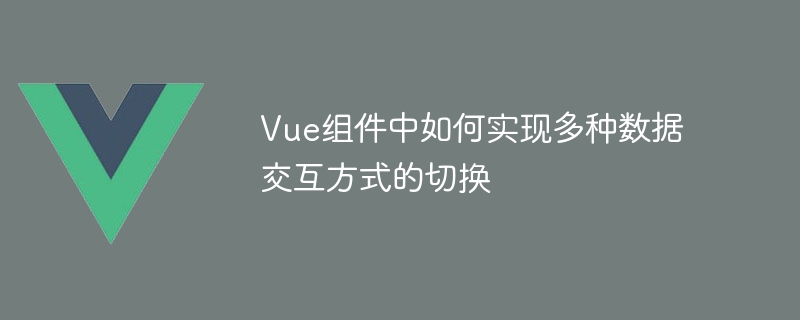所属分类:web前端开发

Vue组件中如何实现多种数据交互方式的切换
在Vue组件开发中,经常会遇到需要切换不同的数据交互方式的场景,比如通过API请求数据、通过表单输入数据或者通过WebSocket实时推送数据等等。本文将介绍如何在Vue组件中实现这种多种数据交互方式的切换,并且会提供具体的代码示例。
在某些情况下,我们需要通过API请求数据来获取后台的数据。下面是一个使用axios库发送API请求的示例:
<template>
<div>
<ul>
<li v-for="item in items" :key="item.id">{{ item.name }}</li>
</ul>
<button @click="fetchData">Fetch Data</button>
</div>
</template>
<script>
import axios from 'axios';
export default {
data() {
return {
items: [],
};
},
methods: {
fetchData() {
axios.get('/api/data')
.then((response) => {
this.items = response.data;
})
.catch((error) => {
console.log(error);
});
},
},
};
</script>上面的示例中,当点击"Fetch Data"按钮时,会发送一个GET请求到后台的/api/data接口,并将返回的数据渲染到页面中。
在用户需要填写表单的情况下,我们可以通过监听表单输入事件来获取用户输入的数据。下面是一个简单的表单输入示例:
<template>
<div>
<form @submit.prevent="handleSubmit">
<input type="text" v-model="username" placeholder="Username" />
<input type="password" v-model="password" placeholder="Password" />
<button type="submit">Login</button>
</form>
<p>{{ message }}</p>
</div>
</template>
<script>
export default {
data() {
return {
username: '',
password: '',
message: '',
};
},
methods: {
handleSubmit() {
// 处理表单提交逻辑
// 可以将用户输入的数据发送到后台,或者进行其他操作
this.message = `Welcome, ${this.username}!`;
this.username = '';
this.password = '';
},
},
};
</script>上面的示例中,当用户输入用户名和密码,并点击"Login"按钮时,会触发表单的提交事件handleSubmit。在handleSubmit方法中,我们可以对表单的数据进行处理,比如将用户名显示在页面上,并清空输入框中的数据。
如果需要实时推送数据,我们可以使用WebSocket来建立与服务器的长连接,并通过WebSocket接收服务器推送的数据。下面是一个使用Vue-WebSocket库来建立WebSocket连接的示例:
<template>
<div>
<ul>
<li v-for="message in messages" :key="message.id">{{ message.content }}</li>
</ul>
</div>
</template>
<script>
import VueWebSocket from 'vue-websocket';
export default {
mixins: [VueWebSocket('ws://localhost:8080/ws')],
data() {
return {
messages: [],
};
},
methods: {
onMessage(event) {
// 处理接收到的推送消息
this.messages.push(JSON.parse(event.data));
},
},
};
</script>上面的示例中,通过Vue-WebSocket库创建了一个WebSocket连接,连接的URL为ws://localhost:8080/ws。在onMessage方法中处理接收到的推送消息,并将其渲染到页面中。
在Vue组件中实现多种数据交互方式的切换,我们可以利用Vue的条件渲染功能,根据不同的状态来显示不同的数据交互方式。下面是一个简单的切换示例:
<template>
<div>
<div v-show="mode === 'api'">
<!-- API请求方式 -->
<ul>
<li v-for="item in items" :key="item.id">{{ item.name }}</li>
</ul>
<button @click="fetchData">Fetch Data</button>
</div>
<div v-show="mode === 'form'">
<!-- 表单输入方式 -->
<form @submit.prevent="handleSubmit">
<input type="text" v-model="username" placeholder="Username" />
<input type="password" v-model="password" placeholder="Password" />
<button type="submit">Login</button>
</form>
<p>{{ message }}</p>
</div>
<div v-show="mode === 'websocket'">
<!-- WebSocket方式 -->
<ul>
<li v-for="message in messages" :key="message.id">{{ message.content }}</li>
</ul>
</div>
<div>
<!-- 切换按钮 -->
<button @click="switchMode('api')">API</button>
<button @click="switchMode('form')">Form</button>
<button @click="switchMode('websocket')">WebSocket</button>
</div>
</div>
</template>
<script>
import axios from 'axios';
import VueWebSocket from 'vue-websocket';
export default {
mixins: [VueWebSocket('ws://localhost:8080/ws')],
data() {
return {
mode: 'api',
items: [],
username: '',
password: '',
message: '',
messages: [],
};
},
methods: {
fetchData() {
axios.get('/api/data')
.then((response) => {
this.items = response.data;
})
.catch((error) => {
console.log(error);
});
},
handleSubmit() {
// 处理表单提交逻辑
// 可以将用户输入的数据发送到后台,或者进行其他操作
this.message = `Welcome, ${this.username}!`;
this.username = '';
this.password = '';
},
onMessage(event) {
// 处理接收到的推送消息
this.messages.push(JSON.parse(event.data));
},
switchMode(mode) {
// 切换数据交互方式
this.mode = mode;
},
},
};
</script>上面的示例中,我们通过v-show指令根据不同的mode值来决定显示哪种数据交互方式的内容。通过点击不同的按钮来切换mode的值,从而达到切换数据交互方式的效果。
总结